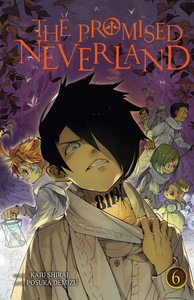Review
by Nick Creamer,The Promised Neverland
GN 6
| Synopsis: |  |
||
Having at last escaped Grace Field House, Emma and her friends find themselves hotly pursued by the demon guardians of their old home. Hunted down in the woods abutting the farm, it seems like all hope is lost - until rescue arrives, in the form of two mysterious strangers. What these strangers have to tell our heroes will shake their understanding of their world to its core, and at last reveal the true scale of the journey before them. Though they've already survived many trials to come this far, the journey stretching before them expands past the horizon - and should they ever falter, the demons at their back will swallow them whole. |
|||
| Review: | |||
Through the past several volumes, The Promised Neverland has been undergoing a dramatic upheaval of nearly all its fundamental narrative variables. Grace Field House has been burned to the ground, Isabella has been outwitted and escaped, and our heroes have found themselves on the run, racing to analyze and overcome an unknown world. Though volume five was largely consumed by illustrating the immediate drama of their escape, as volume six begins, our heroes find themselves suddenly rescued, and at last given some time to catch their breath. So it is that Emma and her friends meet their first friendly “demons” - the diminutive Mujika and the imposing Sanju. In a world where only a few adult humans were ever needed to negotiate for the demons, it was essentially inevitable that Promised Neverland would eventually add some moral complexity to the demons' perspective. After initially presenting these creatures as an unbelievably, almost unknowably horrific mystery, transitioning them into conscious and potentially sympathetic actors carries the risk of undercutting some of Neverland's fundamental tension. Fortunately, not only are Mujika and Sanju both compelling characters in their own right, but their explanation for how this world came to be makes brilliant sense of everything we've learned, all while directly echoing Neverland's most fundamental themes. As Mujika and Sanju reveal, the world wasn't suddenly overrun by demons around thirty years ago. Instead, demons have existed alongside humans for centuries. Though demons once hunted humans freely, after humans began fighting back, the two races decided to entirely separate their worlds. And so the human and demon worlds have continued as separate entities, with one exception - the humans raised as food by the demons, whose ancestors were once offered as a parting gift from the human world. I was genuinely taken aback by how beautifully this explanation resolves all the information we've received so far. Not only did it offer a clean and coherent explanation for the current state of the world, while also providing a clear goal for our heroes, but it accomplished all that while essentially embodying the callous pragmatism that is Emma's mortal enemy. Just as Isabella chose to sacrifice her own child for security within the farm system, so too did humanity as a whole choose to sacrifice Emma's ancestors so they could live in peace. Through the illustration of this smartly chosen backstory, The Promised Neverland recenters its fundamental conflict not on demonic threats, but on the choice between selfish pragmatism and idealistic humanism. Having illustrated that conflict on both the kids' (“we can't save everyone!”) and Isabella's (“I'll sacrifice anyone to save myself”) levels, The Promised Neverland now naturally aims that cynical perspective at humanity at large, an oppressive assumption of selfishness for Emma to challenge with all her might. The explanation of Neverland's world is likely the highlight of this volume, but there's plenty else to enjoy. The slower pace of life with Mujika and Sanju offers natural opportunities to expand on the voices of cast members outside of Emma and Ray, with characters like Gilda and even the younger kids getting some engaging material. Their attempts to help Emma and her friends master this world also give this segment a bit of that classic training arc appeal, though filtered through Neverland's singular perspective (I loved the sequence of Emma coming to terms with hunting animals in order to survive). And though their saviors' subterranean sanctuary doesn't really offer Pozuka Demizu too many opportunities to stretch her illustration talents, it's clear that her mastery of incidental expression work is becoming greater all the time. Pair all that with this volume's ultimately fast-paced transition into the story's next act, and you end up with one of Neverland's strongest volumes yet. On the whole, The Promised Neverland seems to actually be gaining momentum and confidence as it expands beyond the confines of Grace Field House. Though I'd initially worried the manga's inherently time-sensitive premise would leave it soon feeling unfocused, I actually find I'm even more excited about uncovering the mysteries of this world, now that it's pulled off the “big worldbuilding reveal” with such intelligence and grace. It's a wonderful thing to be positively surprised by an already great manga. |
| Grade: | |||
|
Overall : A-
Story : A
Art : B+
+ The true nature of the story's world makes for a smart and riveting reveal, lodged in a sequence of equally compelling smaller stories |
|||
| discuss this in the forum (2 posts) | | |||
| Production Info: | ||
|
Full encyclopedia details about Release information about |
||